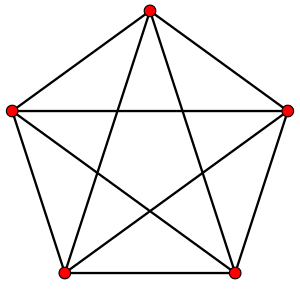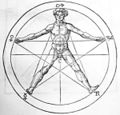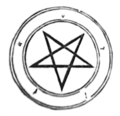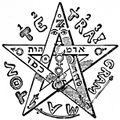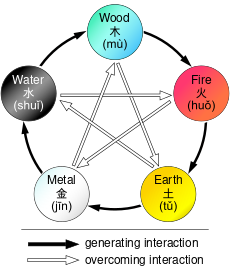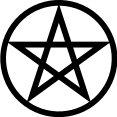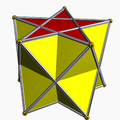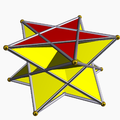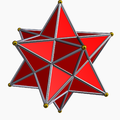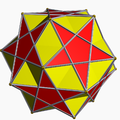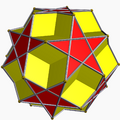نجمة خماسية
| نجمة خماسية منتظمة | |
|---|---|
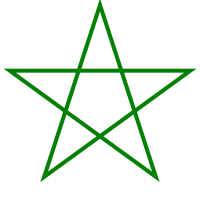 A نجمة خماسية | |
| Type | Star polygon |
| Edges and vertices | 5 |
| Schläfli symbol | {5/2} |
| Coxeter–Dynkin diagram | |
| Symmetry group | D5 (Order 10) |
| Internal angle (degrees) |
36° |
| المضلعات النجمية |
|---|
|
|
في الهندسة الرياضية، النجمة الخماسية هي هو شكل له شكل النجمة الخماسية مرسوم باستخدام خمس قطع مستقيمة. وهو يعتبر أبسط مضلع نجمي. تحتوي النجمة الخماسية على عشرة نقاط، خمسة للرؤوس البارزة وخمسة للزوايا الداخلية، بالإضافة إلى خمسة عشر قطعة مستقيمة. حيث أنها نجمة رسمت بخطوط متساوية الطول تتقاطع في خمس نقاط في الوسط كما أن النسبة بين خطوطها الخمسة تساوي النسبة المقدسة فاي (Phi): 1.618 وهي نسبة مقدسة أو إلهية
pentagram (sometimes known as a pentalpha, pentangle, or star pentagon) is a regular five-pointed star polygon, formed from the diagonal line segments of a convex (or simple, or non-self-intersecting) regular pentagon. Drawing a circle around the five points creates a similar symbol referred to as the pentacle, which is used widely by Wiccans and in paganism, or as a sign of life and connections. The word "pentagram" refers only to the five-pointed star, not the surrounding circle of a pentacle.
Pentagrams were used symbolically in ancient Greece and Babylonia. Christians once commonly used the pentagram to represent the five wounds of Jesus. Today the symbol is widely used by the Wiccans, witches, and pagans. The pentagram has magical associations. Many people who practice neopaganism wear jewelry incorporating the symbol.
The word pentagram comes from the Greek word πεντάγραμμον (pentagrammon),[1] from πέντε (pente), "five" + γραμμή (grammē), "line".[2] Pentagram refers to just the star and pentacle refers to the star within the circle specifically although there is some overlap in usage.[3] The word pentalpha is a 17th-century revival of a post-classical Greek name of the shape.[4]
التاريخ
التاريخ المبكر
Early pentagrams have been found on Sumerian pottery from Ur circa 3500 BCE,[5] and the five-pointed star was at various times the symbol of Ishtar or Marduk.[6][7]


Pentagram symbols from about 5,000 years ago were found in the Liangzhu culture of China.[9]
The pentagram was known to the ancient Greeks, with a depiction on a vase possibly dating back to the 7th century BCE.[10] Pythagoreanism originated in the 6th century BCE and used the pentagram as a symbol of mutual recognition, of wellbeing, and to recognize good deeds and charity.[11]
From around 300-150 BCE the pentagram stood as the symbol of Jerusalem, marked by the 5 Hebrew letters ירשלם spelling its name.[12]
The word Pentemychos (πεντέμυχος lit. "five corners" or "five recesses")[13] was the title of the cosmogony of Pherecydes of Syros.[14] Here, the "five corners" are where the seeds of Chronos are placed within the Earth in order for the cosmos to appear.[15][مطلوب توضيح]
In Neoplatonism, the pentagram was said to have been used as a symbol or sign of recognition by the Pythagoreans, who called the pentagram ὑγιεία hugieia "health"[16]
الرمزية الغربية
العصور الوسطى
The pentagram was used in ancient times as a Christian symbol for the five senses,[17] or of the five wounds of Christ. The pentagram plays an important symbolic role in the 14th-century English poem Sir Gawain and the Green Knight, in which the symbol decorates the shield of the hero, Gawain. The unnamed poet credits the symbol's origin to King Solomon, and explains that each of the five interconnected points represents a virtue tied to a group of five: Gawain is perfect in his five senses and five fingers, faithful to the Five Wounds of Christ, takes courage from the five joys that Mary had of Jesus, and exemplifies the five virtues of knighthood,[18] which are generosity, friendship, chastity, chivalry, and piety.[19]

The North rose of Amiens Cathedral (built in the 13th century) exhibits a pentagram-based motif. Some sources interpret the unusual downward-pointing star as symbolizing the Holy Spirit descending on people.
النهضة
Heinrich Cornelius Agrippa and others perpetuated the popularity of the pentagram as a magic symbol, attributing the five neoplatonic elements to the five points, in typical Renaissance fashion.
الرومانسية
By the mid-19th century, a further distinction had developed amongst occultists regarding the pentagram's orientation. With a single point upwards it depicted spirit presiding over the four elements of matter, and was essentially "good". However, the influential but controversial writer Éliphas Lévi, known for believing that magic was a real science, had called it evil whenever the symbol appeared the other way up.
- "A reversed pentagram, with two points projecting upwards, is a symbol of evil and attracts sinister forces because it overturns the proper order of things and demonstrates the triumph of matter over spirit. It is the goat of lust attacking the heavens with its horns, a sign execrated by initiates."[20]
- "The flaming star, which, when turned upside down, is the heirolgyphic [ك] sign of the goat of black magic, whose head may be drawn in the star, the two horns at the top, the ears to the right and left, the beard at the bottom. It is a sign of antagonism and fatality. It is the goat of lust attacking the heavens with its horns."[21]
- "Let us keep the figure of the Five-pointed Star always upright, with the topmost triangle pointing to heaven, for it is the seat of wisdom, and if the figure is reversed, perversion and evil will be the result."[22]
Man inscribed in a pentagram, from Heinrich Cornelius Agrippa's De occulta philosophia libri tres. The five signs at the pentagram's vertices are astrological.
The occultist and magician Éliphas Lévi's pentagram, which he considered to be a symbol of the microcosm, or human
The apotropaic (protective) use in German folklore of the pentagram symbol (called Drudenfuss in German) is referred to by Goethe in Faust (1808), where a pentagram prevents Mephistopheles from leaving a room (but did not prevent him from entering by the same way, as the outward pointing corner of the diagram happened to be imperfectly drawn):
Mephistopheles:
- I must confess, I’m prevented though
- By a little thing that hinders me,
- The Druid’s-foot on your doorsill–
Faust:
- The Pentagram gives you pain?
- Then tell me, you Son of Hell,
- If that’s the case, how did you gain
- Entry? Are spirits like you cheated?
Mephistopheles:
- Look carefully! It’s not completed:
- One angle, if you inspect it closely
- Has, as you see, been left a little open.[23]
Also protective is the use in Icelandic folklore of a gestured or carved rather than painted pentagram (called smèrhnút in Icelandic), according to 19th century folklorist Jón Árnason:[24]
- A meal that comes from the fake vomit is called a fake meal; it looks like something else; but if one makes a sign of a cross over it, or carves a cross on it, or a figure called a buttermilk-knot,* it all explodes into small pieces and becomes like a grain of dross, so that nothing remains of it, except only particles, or it subsides like foam. Therefore it seems more prudent, if a person is offered a horrible meal to eat, or as a fee, to make either mark on it, because a fake meal cannot withstand either a cross mark or a butter-knot.
- * The buttermilk-knot is shaped like this:

رمزية شرق آسيا
Wu Xing (Chinese: 五行; pinyin: Wǔ Xíng) are the five phases, or five elements in Taoists Chinese tradition. They are differentiated from the formative ancient Japanese or Greek elements, due to their emphasis on cyclic transformations and change. The five phases are: Fire (火 huǒ), Earth (土 tǔ), Metal (金 jīn), Water (水 shuǐ), and Wood (木 mù). The Wuxing is the fundamental philosophy and doctrine of traditional Chinese Medicine and Acupuncture.[25]
الاستخدامات في العبادات الحديثة
Based on Renaissance-era occultism, the pentagram found its way into the symbolism of modern occultists. Its major use is a continuation of the ancient Babylonian use of the pentagram as an apotropaic charm to protect against evil forces.[26] Éliphas Lévi claimed that "The Pentagram expresses the mind's domination over the elements and it is by this sign that we bind the demons of the air, the spirits of fire, the spectres of water, and the ghosts of earth."[27] In this spirit, the Hermetic Order of the Golden Dawn developed the use of the pentagram in the lesser banishing ritual of the pentagram, which is still used to this day by those who practice Golden Dawn-type magic.
Aleister Crowley made use of the pentagram in his Thelemic system of magick: an adverse or inverted pentagram represents the descent of spirit into matter, according to the interpretation of Lon Milo DuQuette.[28] Crowley contradicted his old comrades in the Hermetic Order of the Golden Dawn, who, following Levi, considered this orientation of the symbol evil and associated it with the triumph of matter over spirit.
الاستخدام في الحركات الدينية الحديثة
البهائية

The five-pointed star is a symbol of the Baháʼí Faith.[29][30] In the Baháʼí Faith, the star is known as the Haykal (العربية: "temple"), and it was initiated and established by the Báb. The Báb and Bahá'u'lláh wrote various works in the form of a pentagram.[31][32]
المورمونية
The Church of Jesus Christ of Latter-day Saints is theorized to have begun using both upright and inverted five-pointed stars in Temple architecture, dating from the Nauvoo Illinois Temple dedicated on 30 April 1846.[33] Other temples decorated with five-pointed stars in both orientations include the Salt Lake Temple and the Logan Utah Temple. These usages come from the symbolism found in Revelation chapter 12: "And there appeared a great wonder in heaven; a woman clothed with the sun, and the moon under her feet, and upon her head a crown of twelve stars."[34]
ويكا
Because of a perceived association with Satanism and occultism, many United States schools in the late 1990s sought to prevent students from displaying the pentagram on clothing or jewelry.[35] In public schools, such actions by administrators were determined in 2000 to be in violation of students' First Amendment right to free exercise of religion.[36]
The encircled pentagram (referred to as a pentacle by the plaintiffs) was added to the list of 38 approved religious symbols to be placed on the tombstones of fallen service members at Arlington National Cemetery on 24 April 2007. The decision was made following ten applications from families of fallen soldiers who practiced Wicca. The government paid the families US$225٬000 to settle their pending lawsuits.[37][38]
الاستخدامات الدينية الأخرى
الشيطانية
The inverted pentagram is the symbol used for Satanism, sometimes depicted with the goat's head of Baphomet within it, which originated from the Church of Satan. In some depictions the devil is depicted, like Baphomet, as a goat, therefore the goat and goat's head is a significant symbol throughout Satanism. The inverted pentagram is also used as the logo for The Satanic Temple, which also featured a depiction of Baphomet's head. The Sigil of Baphomet is also adopted by the Joy of Satan Ministries who instead incorporate cuneiform script, attributing it to the earliest use of the pentagram in Sumeria.
ديانة السرر
The five-pointed star is a symbol of the Serer religion and the Serer people of West Africa. Called Yoonir in their language, it symbolizes the universe in the Serer creation myth, and also represents the star Sirius.[39][40]
اليهودية
The pentagram has been used in Judaism since at least 300BCE when it first was used as the stamp of Jerusalem. It is used to represent justice, mercy, and wisdom.
استخدامات حديثة أخرى
- The pentagram is featured on the national flags of Morocco (adopted 1915) and Ethiopia (adopted 1996 and readopted 2009)
- The Order of the Eastern Star, an organization (established 1850) associated with Freemasonry, uses a pentagram as its symbol, with the five isosceles triangles of the points colored blue, yellow, white, green, and red. In most Grand Chapters the pentagram is used pointing down, but in a few, it is pointing up. Grand Chapter officers often have a pentagon inscribed around the star[41](the emblem shown here is from the Prince Hall Association).
Order of the Eastern Star emblem
- A pentagram is featured on the flag of the Dutch city of Haaksbergen, as well on its coat of arms.
التسمية
سميت بالنجمة الخماسية لأنها تتشكل من خمسة خطوط لها خمسة رؤوس وتتقاطع في الوسط في خمسة نقاط لتشكل في وسطها مضلعاً من خمسة أضلع وإذا قمنا بوصل رؤوسها الخمسة سنحصل على مضلعٍ من خمسةِ أضلع يتجه بعكس اتجاه المضلع الموجود في وسط النجمة.
المعنى الرمزي
- هي رمز الذكاء وقوة القدرة الكلية والأتوقراطية كما أنها رمزاً للجمال والكمال.
- هي نجمة السحرة وترمز إلى عالم الإنسان المصنوع من اللحم والدم
- أما اتجاه رؤوسها الخمس فهو أمر غريب يمكن أن يمثل النظام (حيث أن رؤوسها هي نقاط لدائرة واحدة) كما يمكن أن يمثل العشوائية (لعدم وجود أي رأس يتجه باتجاه رأس آخر).
- وعندما تقلب النجمة ليصبح رأسها للأسفل ويوضع عليها صورة رأس العنزة ينطبق رأس العنزة مع رؤوس النجمة ويعتبر رمزاً للشيطان لوسيفر(Lucifer) أو فيسبر(Vesper).
- وفي بداية العصور الوسطى كانت تمثل النشاط والقدرة الشيطانية.
- وقبل ميلاد السيد المسيح كان سيدنا سليمان يرتدي خاتم النجمة الخماسية ليسيطر على الجان والشياطين.
- أما في الشرق فتمثل النجمة الخماسية الكفر والظلم والهلاك الأبدي الروحي والعنزة تمثل التهديد.
- والإسلام قد اتخذها رمزاً لتعاكس الخير والشر.
- وتسمى نجمة الصباح والليل _ النصر أو الموت.
- كما تعتبر النجمة الخماسية المقلوبة وفيها رأس ماعز رمزا لموسيقي الميتال الأسود (Black Metal) وهو نوع من الموسيقى (ينشق من الميتال (Metal) الذي يدعو إلى الرفض والتغيير) يدعو إلى عبادة الشيطان المتمثل بهذه النجمة المقلوبة
الهندسة
The pentagram is the simplest regular star polygon. The pentagram contains ten points (the five points of the star, and the five vertices of the inner pentagon) and fifteen line segments. It is represented by the Schläfli symbol {5/2}. Like a regular pentagon, and a regular pentagon with a pentagram constructed inside it, the regular pentagram has as its symmetry group the dihedral group of order 10.
It can be seen as a net of a pentagonal pyramid although with isosceles triangles.
الإنشاء
The pentagram can be constructed by connecting alternate vertices of a pentagon; see details of the construction. It can also be constructed as a stellation of a pentagon, by extending the edges of a pentagon until the lines intersect.
النسبة الذهبية

The golden ratio, φ = (1 + √5) / 2 ≈ 1.618, satisfying
plays an important role in regular pentagons and pentagrams. Each intersection of edges sections the edges in the golden ratio: the ratio of the length of the edge to the longer segment is φ, as is the length of the longer segment to the shorter. Also, the ratio of the length of the shorter segment to the segment bounded by the two intersecting edges (a side of the pentagon in the pentagram's center) is φ. As the four-color illustration shows:
The pentagram includes ten isosceles triangles: five acute and five obtuse isosceles triangles. In all of them, the ratio of the longer side to the shorter side is φ. The acute triangles are golden triangles. The obtuse isosceles triangle highlighted via the colored lines in the illustration is a golden gnomon.
قيم حساب المثلثات
As a result, in an isosceles triangle with one or two angles of 36°, the longer of the two side lengths is φ times that of the shorter of the two, both in the case of the acute as in the case of the obtuse triangle.
النجمة الخماسية الكرية
A pentagram can be drawn as a star polygon on a sphere, composed of five great circle arcs, whose all internal angles are right angles. This shape was described by John Napier in his 1614 book Mirifici logarithmorum canonis descriptio (Description of the wonderful rule of logarithms) along with rules that link the values of trigonometric functions of five parts of a right spherical triangle (two angles and three sides). It was studied later by Carl Friedrich Gauss.
أشكال ثلاثية الأبعاد
Several polyhedra incorporate pentagrams:
أبعاد أعلى
Orthogonal projections of higher dimensional polytopes can also create pentagrammic figures:
| 4D | 5D | ||
|---|---|---|---|
 The regular 5-cell (4-simplex) has five vertices and 10 edges. |
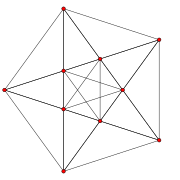 The rectified 5-cell has 10 vertices and 30 edges. |
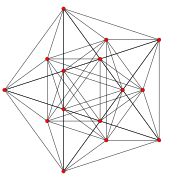 The rectified 5-simplex has 15 vertices, seen in this orthogonal projection as three nested pentagrams. |
 The birectified 5-simplex has 20 vertices, seen in this orthogonal projection as four overlapping pentagrams. |
All ten 4-dimensional Schläfli–Hess 4-polytopes have either pentagrammic faces or vertex figure elements.
نجمة ڤينوس
The pentagram of Venus is the apparent path of the planet Venus as observed from Earth. Successive inferior conjunctions of Venus repeat with an orbital resonance of approximately 13:8—that is, Venus orbits the Sun approximately 13 times for every eight orbits of Earth—shifting 144° at each inferior conjunction.[43] The tips of the five loops at the center of the figure have the same geometric relationship to one another as the five vertices, or points, of a pentagram, and each group of five intersections equidistant from the figure's center have the same geometric relationship.
في أنظمة الحاسب
The pentagram has these Unicode code points that enable them to be included in documents:
- U+26E4 ⛤ pentagram
- U+26E5 ⛥ right-handed interlaced pentagram
- U+26E6 ⛦ left-handed interlaced pentagram
- U+26E7 ⛧ inverted pentagram
انظر أيضاً
- Abe no Seimei
- Christian symbolism
- Command at Sea insignia
- Enneagram (geometry)
- Five-pointed star
- Heptagram
- Hexagram
- Lute of Pythagoras
- Medal of Honor
- Pentachoron – the 4-simplex
- Pentagram map
- Pentalpha
- Petersen graph
- Ptolemy's theorem
- Seal of Solomon
- Star polygons in art and culture
- Star (heraldry)
- Stellated polygons
الهوامش
- ^ πεντάγραμμον, Henry George Liddell, Robert Scott, A Greek-English Lexicon, on Perseus; a noun form of adjectival πεντάγραμμος (pentagrammos) or πεντέγραμμος (pentegrammos), a word meaning roughly "five-lined" or "five lines"
- ^ πέντε, Henry George Liddell, Robert Scott, A Greek-English Lexicon, on Perseus; Satan all 3 names mentioned before daylight full γραμμή, Henry George Liddell, Robert Scott, A Greek-English Lexicon, on Perseus
- ^ this usage is borne out by the Oxford English Dictionary, although that work specifies that a circumscription makes the form of a five-pointed star and its etymon post-classical Latin pentaculum [...] A pentagram, esp. one enclosed in a circle; a talisman or magical symbol in the shape of or inscribed with a pentagram. Also, in extended use: any similar magical symbol (freq. applied to a hexagram formed by two intersecting or interlaced equilateral triangles)."
- ^ πένταλϕα, "five Alphas", interpreting the shape as five Α shapes overlapping at 72-degree angles.
- ^ "History of the Pentagram — D. J. Scott's Oldschool Website". djonscott.com.
- ^ Budge, Sir E. A. Wallis (1968). Amulets and Talismans. p. 433.
- ^ Scott, Dustin Jon (2006). "History of the Pentagram". Retrieved 18 May 2021.
- ^ Allman, G. J., Greek Geometry From Thales to Euclid (1889), p.26.
- ^ 馬愛平 (September 23, 2019). "距今5000年!良渚文物中發現最古老五角星圖案" (in Chinese). China Daily.
{{cite web}}: CS1 maint: unrecognized language (link) - ^ Coxeter, H.S.M.; Regular Polytopes, 3rd edn, Dover, 1973, p. 114.
- ^ Ball, W. W. Rouse and Coxeter, H. S. M.; Mathematical Recreations and Essays, 13th Edn., Dover, 1987, p. 176.
- ^ "Star of David vs. Pentagram: Everything You Need to Know". 17 July 2020.
- ^ πεντέμυχος, Henry George Liddell, Robert Scott, A Greek-English Lexicon, on Perseus
- ^ This is a lost book, but its contents are preserved in Damascius, De principiis, quoted in Kirk and Raven, (1983) [1956], p. 55.
- ^ "the divine products of Chronos' seed, when disposed in five recesses, were called πεντέμυχος (Pentemychos)" Kirk, Geoffrey Stephen; Raven, John Earle; Schofield, Malcolm (1983) [1957]. The Presocratic Philosophers: A Critical History with a Selection of Texts (2nd, illustrated, revised, reprint ed.). Cambridge University Press. pp. 51–52, 55. ISBN 978-0-521-27455-5.
the only other place in Homer where Ortygie [ك] is mentioned is Odyssey V, 123, where Orion, having been carried off by Eos [the dawn], is slain... by Artemis... since solstices would normally be observed at sunrise in summer, and so in the north-east-by-east direction, that is what the phrase might suggest... the dwelling-place of Eos... Aia..
- ^ Allman, G. J., Greek Geometry From Thales to Euclid, part I (1877), in Hermathena 3.5, pp. 183, 197, citing Iamblichus and the Scholiast on Aristophanes. The pentagram was said to have been so called from Pythagoras himself having written the letters Υ, Γ, Ι, Θ (= /ei/), Α on its vertices.
- ^ Christian Symbols Ancient and Modern, Child, Heather and Dorothy Colles. New York: Charles Scribner's Sons, 1971, ISBN 0-7135-1960-6.
- ^ Morgan, Gerald (1979). "The Significance of the Pentangle Symbolism in "Sir Gawain and the Green Knight"". The Modern Language Review. 74 (4): 769–790. doi:10.2307/3728227. JSTOR 3728227.
- ^ Sir Gawain and the Green Knight, lines 619–665
- ^ Lévi, Éliphas (1999) [1896 (translated), 1854 (first published)]. Transcendental Magic, its Doctrine and Ritual [Dogme et rituel de la haute magie]. Trans. by A. E. Waite. York Beach: Weiser. OCLC 263626874.
- ^ Lévi, Éliphas (2002) [1939 (translated), 1859 (first published)]. The Key of the Mysteries [la Clef des grands mystères suivant Hénoch, Abraham, Hermès Trismégiste et Salomon]. Trans. by Aleister Crowley. Boston: Weiser. p. 69. OCLC 49053462.
- ^ Hartmann, Franz (1895) [1886]. Magic, White and Black (5th ed.). New York: The Path. OCLC 476635673.
- ^ "Goethe, Johann Wolfgang von (1749–1832) - Faust, Part I: Scenes I to III". www.poetryintranslation.com. Retrieved 2021-05-25.
- ^ Árnason, Jón (1862). "Töfrabrogð [Magic trick]". Íslenzkar Þjoðsögur og Æfintýri [Icelandic Folktales and Legends] (in الأيسلندية). Vol. 1. Leipzig: J. C. Hinrich's Bookstore. p. 432.
Smèr það, er verður af tilberaspýunni, er kallað tilberasmèr; er það útlits sem annað smèr; en gjöri maður krossmark yfir því, eða risti á það kross, eða mynd þá, er smèrhnútur heitir,* springur það alt í smámola og verður eins og draflakyrníngur , svo ekki sèst eptir af því, nema agnir einar, eða það hjaðnar niður sem froða. Þykir það því varlegra, ef manni er boðið óhrjálegt smèr að borða, eða í gjöld, að gjóra annaðhvort þetta mark á það, því tilberasmèr þolir hvorki krossmark né smjörhnút. / * Smèrhnútur er svo í lögun:

- ^ Chen, Yuan Julian (2014). ""Legitimation Discourse and the Theory of the Five Elements in Imperial China." Journal of Song-Yuan Studies 44 (2014): 325-364". Journal of Song-Yuan Studies (in الإنجليزية). 44 (1): 325–364. doi:10.1353/sys.2014.0000. S2CID 147099574.
- ^ Schouten, Jan (1968). The Pentagram as Medical Symbol: An Iconological Study. Hes & De Graaf. p. 18. ISBN 978-90-6004-166-6.
- ^ Waite, Arthur Edward (1886). The Mysteries of Magic: A Digest of the Writings of Eliphas Lévi. London: George Redway. p. 136.
- ^ DuQuette, Lon Milo (2003). The Magick of Aleister Crowley: A Handbook of the Rituals of Thelema. Weiser Books. pp. 93, 247. ISBN 978-1-57863-299-2.
- ^ "Bahá'í Reference Library - Directives from the Guardian, Pages 51-52". reference.bahai.org.
- ^ "The Nine-Pointed Star". bahai-library.com.
- ^ Moojan Momen (2019). The Star Tablet of the Bab. British Library Blog.
- ^ Bayat, Mohamad Ghasem (2001). An Introduction to the Súratu'l-Haykal (Discourse of The Temple) in Lights of Irfan, Book 2.
- ^ See the Nauvoo Temple Archived 17 مايو 2020 at the Wayback Machine website discussing its architecture, and particularly the page on Nauvoo Temple exterior symbolism Archived 17 مايو 2020 at the Wayback Machine. Retrieved 16 December 2006.
- ^ Brown, Matthew B (2002). "Inverted Stars on LDS Temples" (PDF). FAIRLDS.org. Archived from the original (PDF) on 29 February 2008.
- ^ "Religious Clothing in School", Robinson, B.A., Ontario Consultants on Religious Tolerance, 20 August 1999, updated 29 April 2005. Retrieved 10 February 2006. "ACLU Defends Honor Student Witch Pentacle" (Press release). American Civil Liberties Union of Michigan. 10 February 1999. Archived from the original on 8 November 2003. Retrieved 10 February 2006.
{{cite press release}}: CS1 maint: bot: original URL status unknown (link) "Witches and wardrobes: Boy says he was suspended from school for wearing magical symbol" Rouvalis, Cristina; Pittsburgh Post-Gazette, 27 September 2000. Retrieved 10 February 2006. - ^ "Federal judge upholds Indiana students' right to wear Wiccan symbols". Associated Press. 1 May 2000. Archived from the original on 30 March 2014. Retrieved 21 September 2007.
{{cite web}}: CS1 maint: bot: original URL status unknown (link) - ^ "Wiccan symbol OK for soldiers' graves". CNN.com. Associated Press. 23 April 2007. Archived from the original on 26 April 2007.
- ^ "Burial and Memorials: Available Emblems of Belief for Placement on Government Headstones and Markers". United States Department of Veterans Affairs. 3 July 2013. Retrieved 13 January 2014.
- ^ Gravrand 1990, p. 20.
- ^ Madiya, Clémentine Faïk-Nzuji (1996). Tracing Memory: A Glossary of Graphic Signs and Symbols in African Art and Culture. Mercury series, no. 71. Hull, Québec: Canadian Museum of Civilization. pp. 27, 155. ISBN 0-660-15965-1.
- ^ Ritual of the Order of the Eastern Star, 1976
- ^ Pietrocola, Giorgio (2005). "Tartapelago. Exposure of fractals". Maecla.
- ^ Baez, John (4 January 2014). "The Pentagram of Venus". Azimuth. Archived from the original on 14 December 2015. Retrieved 7 January 2016.
المصادر
- Grünbaum, B. and G. C. Shephard; Tilings and Patterns, New York: W. H. Freeman & Co., (1987), ISBN 0-7167-1193-1.
- Grünbaum, B.; Polyhedra with Hollow Faces, Proc of NATO-ASI Conference on Polytopes ... etc. (Toronto 1993), ed T. Bisztriczky et al., Kluwer Academic (1994) pp. 43–70.
وصلات خارجية
- Eric W. Weisstein, Pentagram at MathWorld.
- The Pythagorean Pentacle from the Biblioteca Arcana.
- In-depth analysis of the Golden Ratio
- The pentagram and Freemasonry
- Articles containing آيسلندية-language text
- CS1 الأيسلندية-language sources (is)
- CS1 maint: bot: original URL status unknown
- Short description is different from Wikidata
- Articles containing Ancient Greek (to 1453)-language text
- جميع الصفحات التي تحتاج تنظيف
- مقالات بالمعرفة تحتاج توضيح from December 2018
- Articles containing Chinese-language text
- Articles with hatnote templates targeting a nonexistent page
- Articles containing explicitly cited عربية-language text
- Pages using multiple image with auto scaled images
- رموز مسيحية
- Golden ratio
- سحر (ما وراء الطبيعة)
- رموز وطنية إثيوبية
- رموز وطنية مغربية
- مضلعات
- رموز نجوم
- رموز دينية
- Magic symbols
- National symbols of Ethiopia
- National symbols of Morocco
- 5 (number)
- Pythagorean symbols
- Religious symbols
- Star polygons
- Serer religious symbols
- ويكا
